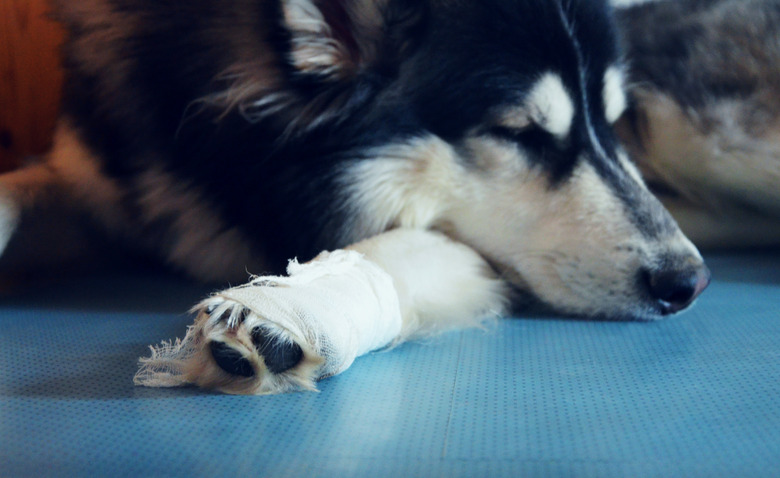How To Wrap A Dog's Paw So The Dressing Won't Come Off
The paw is one of the areas a pooch is most likely to injure. He may step on something that cuts it, get heat blisters on hot pavement, break off a toenail, run until he's gotten blisters between its pads, puncture his foot while digging, cut it on ice on a cold day, or injure his paw in dozens of other ways. Unfortunately, while the paw is one of the most common places for a dog to injure himself, it's also one of the hardest places to bandage, especially since you can't just give a dog a Band-Aid. Dogs can tear through bandages by walking, chewing through them to get free, or scratching at them with their other paws. However, it is possible to wrap up a paw so the dressing won't come off if you know what you're doing.
Applying a dog paw wrap
Applying a dog paw wrap
The first thing you'll need to do is treat the injury. Clean it, disinfect it, and apply an antibiotic ointment. Next, put an absorbent, nonstick pad over the wound. Then, wrap a gauze bandage around the pad and cover a little of the dog's fur on each side of it. Each time you wrap the gauze bandage, a third of the last layer should remain exposed.
While many people put the dog paw in a wrap using an Ace bandage because it's something they already have on hand, it's better to get a self-adhesive bandage like Vet Wrap since this sticks to itself and makes the entire dressing harder to remove. Apply a layer of this bandage over the gauze. Be sure not to wrap the bandage too tightly, or you may cut off circulation, according to Pet Health Network. Wrap the bandage a few inches above the wound around the dog's ankle. Then, wrap medical tape around the bandage to secure it.
Assure she can walk
Assure she can walk
When a dog's paw is bandaged too tightly, her toes won't be able to spread out once she puts pressure on it, and that will make it difficult to walk. Even the most patient and well-behaved pup might go crazy trying to get a bandage off her paw if she can't walk with it on.
Sometimes a semi-tight bandage is required for certain injury types, but if the bandage doesn't need to be tight on the dog's toes, be sure you leave plenty of slack in the dressing when wrapping around her toes and pads. You may choose to leave the toes exposed altogether if possible.
If you're only bandaging her feet so she won't scratch the rest of her body, consider using dog socks to prevent scratching. Just apply a clean sock around her foot and then use medical tape or even duct tape at the top of the opening. Always keep the tape on the sock, not on her fur.
Extra precautions
Extra precautions
Because dog paws are so difficult to keep bandaged, there are a few extra things you can do to keep the dressing secure. An affordable option is to put a sock over the bandage and then tape it at the top of the bandage, being careful not to stick the tape to his fur. Alternatively, LoveToKnow suggests getting a protective boot like Medipaw or Surgi-Sox that is specially designed to slide over a bandage to prevent chewing and slipping.
Consider using a cone
Consider using a cone
No one likes the dreaded cone of shame, also known as Elizabethan collars, but the reality is that some dogs just won't leave their bandages alone as long as they can chew on them. While your dog might not be happy about her new look, you can at least be happy knowing her injury will heal quicker if she's not constantly removing the bandage.
Always check with your veterinarian before changing your pet's diet, medication, or physical activity routines. This information is not a substitute for a vet's opinion.
